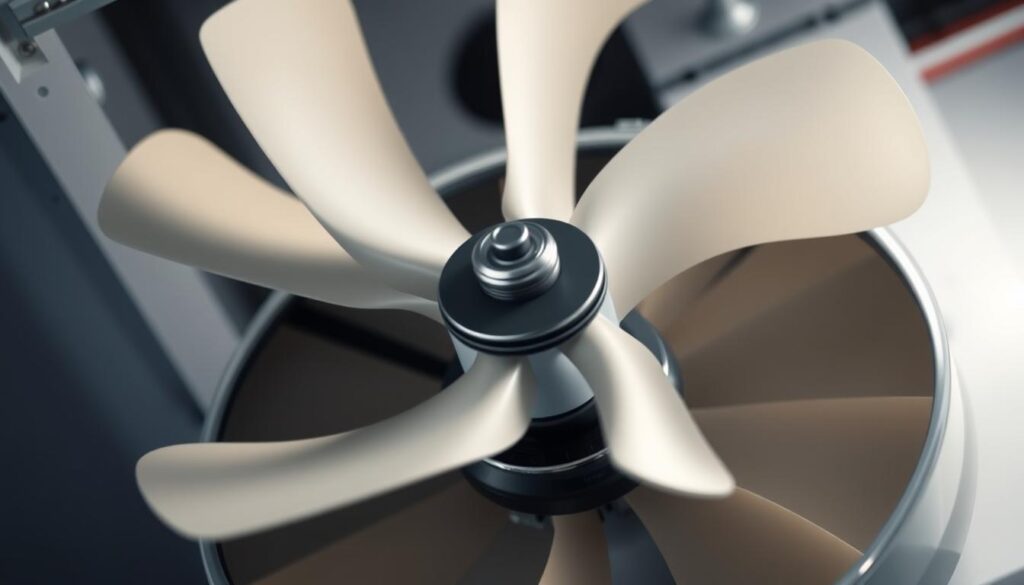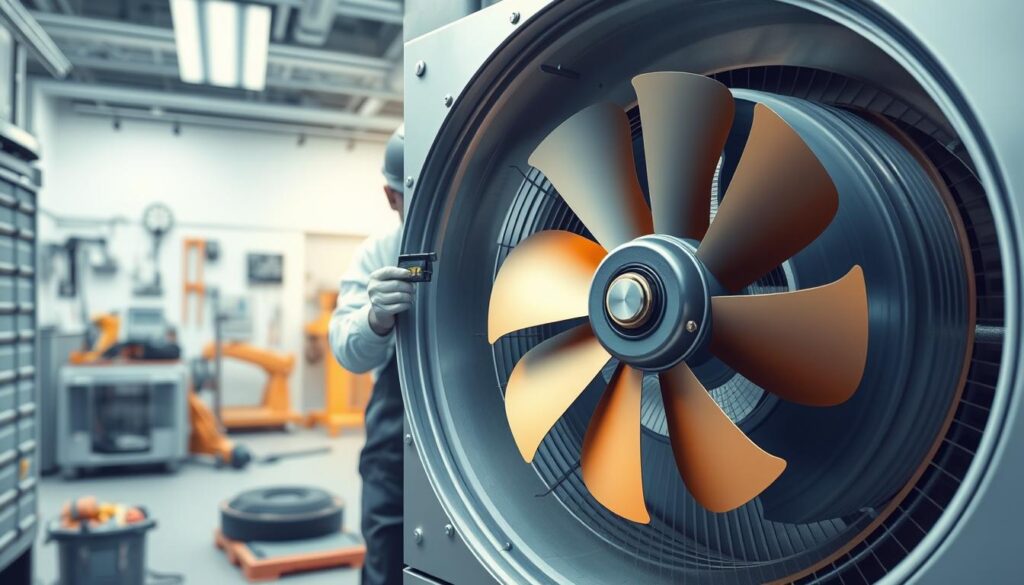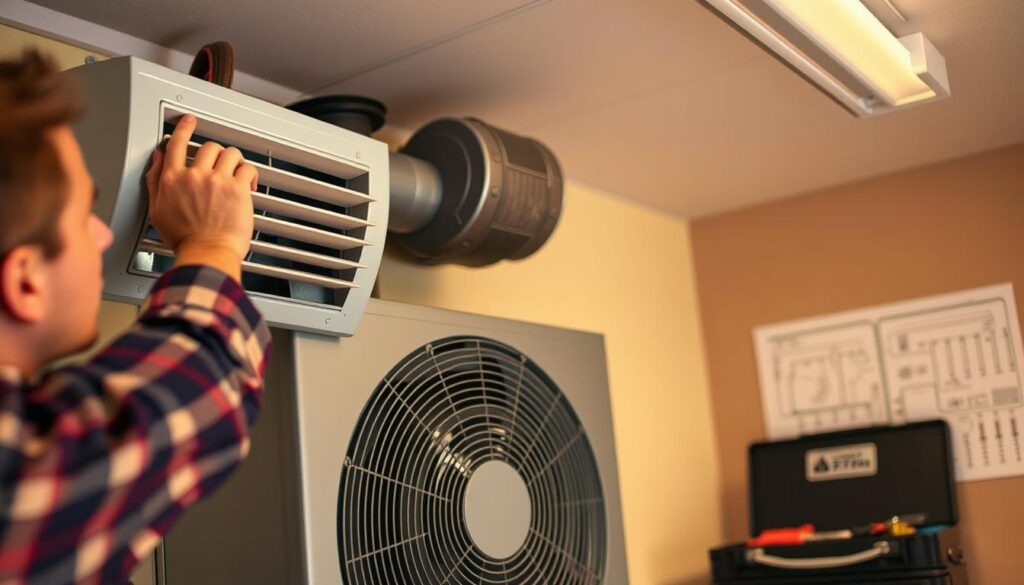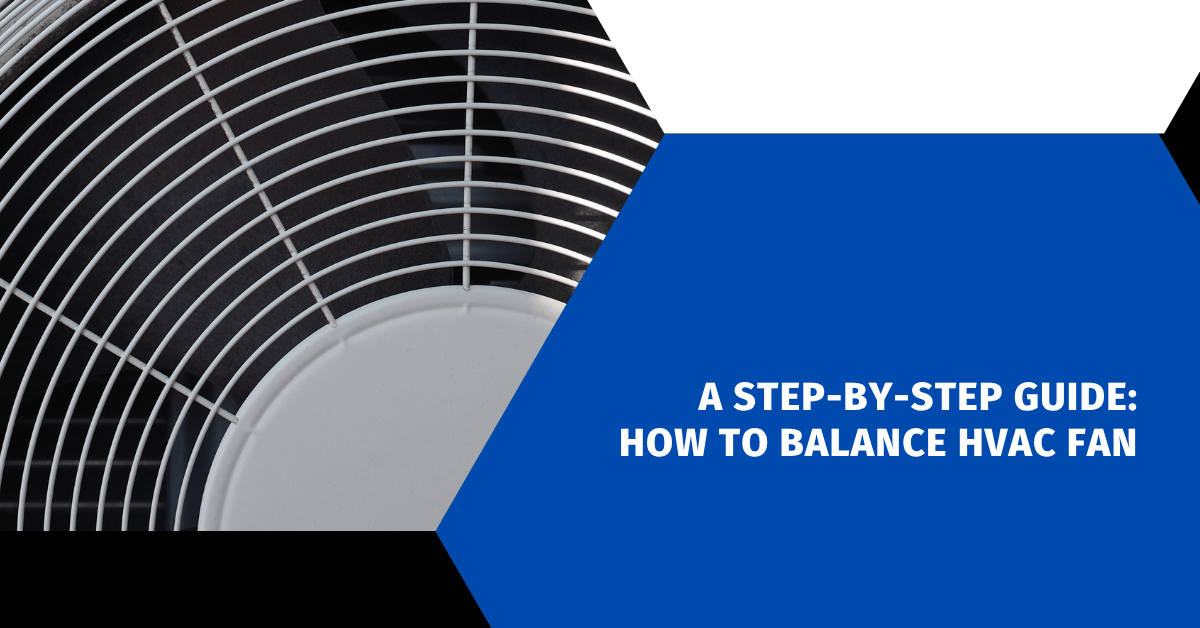Affiliate Disclosure
HVAC Guide Guys is a participant in the Amazon Services LLC Associates Program, an affiliate advertising program designed to provide a means for sites to earn advertising fees by advertising and linking to Amazon.
How to Balance HVAC Fan? Ever noticed how some rooms in your home are freezing, while others are sweltering? The answer might be in your HVAC system’s fan balance. Learning to balance your ac fan is more than just a technical task. It’s the secret to making your home both comfortable and energy-efficient.

When you figure out how to balance your HVAC fan, you’re making a big step towards a more cozy home. Your HVAC system is designed to spread air evenly. But without the right balance, it can’t keep temperatures steady or work at its best.
This guide will show you how to balance your AC fan. You’ll learn how to make your home more comfortable and cut down on energy use. Whether you love DIY projects or just want to know more about your HVAC system, you’ll find useful tips here.
Key Takeaways
- HVAC fan balancing improves overall system efficiency
- Unbalanced fans can lead to inconsistent room temperatures
- Proper balancing reduces energy consumption
- Regular maintenance extends HVAC system lifespan
- Professional tools can help achieve precise fan balance
Table of Contents
Understanding HVAC Fan Balancing Fundamentals
Keeping your home comfortable and efficient is key. Knowing how to balance your HVAC system is essential. It affects your comfort, energy use, and air quality.
HVAC fan balancing is all about precision. It makes sure your system works smoothly and efficiently. It’s like a musical instrument – every part must work together perfectly.
Benefits of Proper Fan Balance
Having a balanced HVAC system brings many benefits:
- Less wear and tear on mechanical parts
- Better indoor comfort
- Lower energy bills
- A quieter system
- Longer life for your equipment
Common Signs of an Unbalanced Fan
Spotting signs of an unbalanced fan is the first step. Look out for these:
- Unusual vibrations when it’s running
- Temperatures in rooms that don’t match
- Strange or loud noises
- Higher energy costs
Impact on Energy Efficiency
An unbalanced HVAC system can really up your energy bills. Misaligned fans use more electricity and lower efficiency. Regular checks and balancing can save you money and make your home more comfortable.
Proper fan balancing is not just a technical procedure, but an investment in your home’s comfort and efficiency.
Explore Our HVAC Shop
Looking for top-rated HVAC tools, parts, and accessories? Visit our shop and find the perfect solution for your needs.
Visit the ShopEssential Tools and Equipment for Fan Balancing
Having the right tools is crucial for hvac airflow balancing. Professional HVAC technicians use special equipment. This ensures the hvac fan speed is just right for the best system performance.
Your HVAC balancing toolkit should include several key instruments:
- Anemometers: Precision devices for measuring air velocity and volume
- Digital manometers: Used to check static pressure in ductwork
- Infrared thermography cameras: Detect temperature variations across systems
- Airflow measurement hoods: Capture comprehensive airflow data
Professional technicians use these tools to find and fix airflow problems. An anemometer measures air speed at different registers. Infrared cameras show temperature differences that might mean the fans aren’t balanced right.
To do hvac airflow balancing well, you need quality tools. Digital tools give more accurate readings than old analog ones. Think about getting a full HVAC testing kit with many devices.
Accurate measurements are the foundation of effective HVAC system optimization.
Using the right equipment helps you find and fix airflow issues fast. This can save a lot of energy and make your system work better.
Preparing Your HVAC System for Balance Testing
Before you start fixing hvac fan vibrations, getting ready is key. Your HVAC system needs a good check-up before any tests. This makes sure measurements are right and safe.
Initial System Inspection
First, you need to inspect your system well. Look at important parts closely:
- Check for visible ductwork damage
- Inspect fan blades for signs of wear
- Verify motor mounting stability
- Ensure all access panels are secure
Gathering System Documentation
Next, gather all important documents. These help a lot with balancing:
| Document Type | Purpose |
|---|---|
| Original Equipment Specifications | Verify design parameters |
| Duct Layout Diagrams | Understand airflow pathways |
| Previous Maintenance Records | Track historical performance |
Safety Precautions Before Starting
Your safety is the most important thing when fixing hvac fan vibrations. Always wear protective gear and follow these steps:
- Disconnect electrical power before inspection
- Use appropriate personal protective equipment
- Work with a partner when possible
- Verify system is cool and depressurized
Good preparation is the first step to successful HVAC fan balancing. It helps your system work better and last longer.
Explore Our HVAC Shop
Looking for top-rated HVAC tools, parts, and accessories? Visit our shop and find the perfect solution for your needs.
Visit the ShopHow to Balance HVAC Fan: Step-by-Step Process

Balancing an HVAC fan needs precision and attention to detail. Your home’s comfort depends on good airflow. This makes balancing your hvac system key for the best performance.
First, get your HVAC ready for balance testing. You’ll need some important tools:
- Digital anemometer
- Measuring tape
- Screwdriver
- Notebook for recording measurements
To learn how to balance your hvac fan, follow these steps:
- Check all air registers and vents
- Open all dampers fully
- Measure airflow at each register
- Find areas with too little or too much airflow
- Adjust dampers a little at a time
- Test and record new airflow measurements
Experts say you might need to adjust a few times to get it right. Being patient is important. Making small changes helps avoid overdoing it and keeps airflow even.
Proper fan balancing can improve energy efficiency by up to 20% and enhance overall system performance.
Remember, every HVAC system is different. What works for one home might need tweaks for another. Always focus on systematic measurement and careful adjustments when balancing your hvac system.
Measuring and Adjusting Airflow Distribution
To get the best out of your HVAC system, you need to be precise. You’ll need special tools to measure and adjust the airflow. This ensures air flows evenly in your space.
Experts use advanced tools to fine-tune your HVAC system. They check the fan speed and airflow. This careful process boosts your system’s performance.
Using Anemometers and Flow Hoods
Anemometers are key for checking air speed and volume. They help you:
- Find out how fast air moves at each outlet
- Spot any air flow blocks
- See if your system meets design standards
Recording Airflow Measurements
Keeping detailed records is vital for balancing airflow. Make a log that includes:
- Readings for each outlet’s airflow
- Temperature differences
- Pressure levels
Making Precise Damper Adjustments
After getting your data, you’ll adjust the dampers. This step needs:
- A careful plan for balancing airflow
- Small changes to the dampers
- More checks to see if it worked
“Precision in airflow measurement is the key to optimal HVAC system performance.” – HVAC Engineering Professionals
Using these methods can greatly improve your HVAC system. It will work better, be more comfortable, and save energy.
Explore Our HVAC Shop
Looking for top-rated HVAC tools, parts, and accessories? Visit our shop and find the perfect solution for your needs.
Visit the ShopAdvanced Techniques for System Optimization
Professional HVAC technicians use the latest technologies to improve fan balancing. They use advanced software and tools for better system performance.
Today’s fan balancing techniques include new methods:
- Digital airflow modeling software
- Infrared thermography analysis
- Automated real-time balancing systems
- Smart sensor integration
Infrared thermal imaging shows temperature patterns not seen by the eye. It helps find airflow issues with great accuracy.
| Advanced Technique | Key Benefits | Implementation Complexity |
|---|---|---|
| Digital Airflow Modeling | Precise system mapping | High |
| Infrared Thermography | Detailed heat pattern analysis | Medium |
| Automated Balancing Dampers | Real-time system adjustments | Very High |
Smart HVAC systems have adaptive balancing technologies. They watch and adjust airflow constantly. These systems can spot small changes and adjust, keeping your space comfortable and saving energy.
Professional-grade HVAC optimization needs advanced technology and expert skills.
Using these advanced methods, you can turn your HVAC system into a high-tech comfort solution.
Troubleshooting Common Balance Issues
HVAC systems can face many challenges that affect their performance. It’s important to know how to fix unbalanced hvac blower problems and solve hvac fan vibration issues. This keeps your system running well.
Professional HVAC technicians deal with many balance problems. They need to diagnose and fix these issues carefully. Spotting problems early can avoid bigger damage and expensive fixes.
Navigating Pressure Imbalances
Pressure imbalances can make your home uncomfortable. These issues might show up as:
- Doors slamming unexpectedly
- Difficulty opening or closing windows
- Uneven air distribution across rooms
Addressing Noise Problems
Strange sounds from your HVAC system can mean balance issues. To solve hvac fan vibration problems, try these steps:
- Find where the vibration is coming from
- Check if the mounting hardware is loose
- Look at the fan blade alignment
Resolving Temperature Inconsistencies
Temperature changes can point to deeper system problems. Here are ways to find and fix these issues:
| Symptom | Potential Cause | Recommended Action |
|---|---|---|
| Cold spots | Blocked ductwork | Inspect and clear obstructions |
| Uneven heating/cooling | Incorrect damper settings | Recalibrate system dampers |
| Persistent temperature differences | Inadequate insulation | Evaluate and improve ductwork insulation |
Getting a professional to check your system is the best way. They can fix unbalanced hvac blower systems and ensure your comfort and performance for a long time.
Explore Our HVAC Shop
Looking for top-rated HVAC tools, parts, and accessories? Visit our shop and find the perfect solution for your needs.
Visit the ShopMaintaining Balanced Airflow Long-term

Keeping your HVAC system balanced needs ongoing effort and proactive care. It’s key to use the right fan balancing techniques. This ensures your home stays comfortable and energy-efficient.
To keep your HVAC system balanced for a long time, follow a smart maintenance plan:
- Change air filters every 90 days or as the maker suggests
- Check ductwork yearly for leaks or damage
- Clean air vents and registers every three months
- Get professional HVAC system checks every six months
Your home’s changes can affect system balance. Renovations, furniture moves, or building changes can change airflow. Smart HVAC systems can adjust to these changes automatically.
Look out for signs your system needs rebalancing:
- Rooms not heating or cooling evenly
- Strange noises from vents
- Higher energy bills
- Less comfort overall
By regularly maintaining your HVAC system and watching its performance, you’ll keep airflow balanced. This will save energy, improve comfort, and make your system last longer.
Conclusion
Balancing your HVAC fan is key to a comfy and efficient home. Knowing how to balance your HVAC fan can greatly improve your home’s air flow and energy use. This guide offers a detailed way to balance hvac airflow, helping you solve many ventilation problems.
Some homeowners can handle simple fan balancing tasks. But, complex systems need a pro’s touch. If you’re stuck with airflow issues or unsure about balancing, get a certified HVAC tech’s help. They can do detailed checks and fixes that DIY can’t match.
Keeping your HVAC system in check is a continuous job. Regular checks, balancing, and care can make your system last longer and work better. By focusing on hvac airflow balancing, you’ll make your home more comfortable. You might also save on energy and avoid early wear on your HVAC.
Starting your HVAC balancing journey is all about knowing and doing the right thing. You can do it yourself or get a pro. The important thing is to watch your system’s performance and fix any problems fast.

